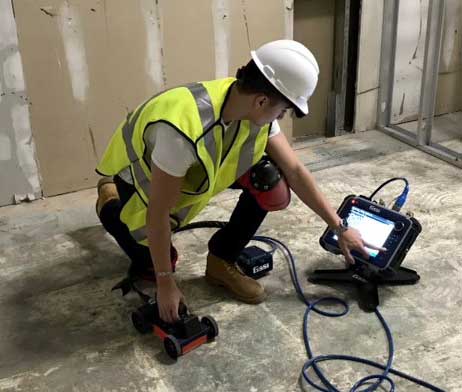Enhance Project Effectiveness with RainierGPR Concrete Scanning Providers
Enhance Project Effectiveness with RainierGPR Concrete Scanning Providers
Blog Article
Exploring the Midst: A Comprehensive Guide to Concrete Scanning and Its Diverse Applications
In the world of construction and infrastructure growth, the thorough process of concrete scanning holds a critical function in guaranteeing the architectural honesty and safety and security of jobs. As modern technology proceeds to progress, the applications of concrete scanning have actually expanded much beyond plain surface-level analyses.
Relevance of Concrete Scanning
Recognizing the importance of concrete scanning is crucial in guaranteeing the safety and security and honesty of frameworks during building and construction and remodelling tasks. Concrete scanning utilizes sophisticated innovations such as ground-penetrating radar (GPR) and electro-magnetic induction to discover ingrained objects, spaces, or various other anomalies within concrete structures - RainierGPR Concrete Scanning. By carrying out detailed scans prior to exploration, cutting, or coring into concrete, building and construction groups can prevent unintentional damage to vital structural components like rebar, avenues, or post-tension cable televisions. This proactive technique not just stops expensive repair work and project hold-ups however likewise enhances general building safety and security by reducing the risk of architectural failings or collapses due to endangered integrity.
Furthermore, concrete scanning plays a pivotal role in guaranteeing conformity with building regulations and guidelines that mandate the defense of existing structural elements throughout construction activities. By accurately mapping out the inner composition of concrete, scanning technologies make it possible for building specialists to make informed choices that promote the architectural security and longevity of structures and facilities jobs. Essentially, the value of concrete scanning depends on its ability to safeguard both the architectural integrity and the personnel associated with construction endeavors.
Technologies Utilized in Concrete Scanning
Concrete scanning counts on sophisticated modern technologies such as ground-penetrating radar (GPR) and electro-magnetic induction to accurately detect embedded objects and abnormalities within concrete frameworks. Ground-penetrating radar runs by sending out high-frequency electromagnetic waves right into the concrete. When these waves come across different products or voids within the concrete, they recover to the surface, permitting the GPR system to produce an in-depth subsurface photo. This modern technology is specifically efficient in locating rebar, post-tension wires, avenues, and other objects installed in concrete.
Electro-magnetic induction, on the various other hand, works by generating electromagnetic fields around a concrete structure with a transmitter coil. When steel things exist within the concrete, they interfere with these electromagnetic fields, causing eddy currents to stream with the steel. By measuring the modifications in the magnetic fields with a receiver coil, the system can determine the area of metallic items in the concrete.
These innovative modern technologies play a vital function in non-destructive testing, ensuring the safety and security and honesty of concrete structures in different markets.
Applications in Building Sector
Within the construction industry, concrete scanning technology finds varied applications Visit Website that improve task effectiveness and safety. In addition, concrete scanning is made use of for situating spaces, such as air pockets or areas of wear and tear within concrete, which can jeopardize the total strength of a framework. Concrete scanning plays a crucial duty in top quality control by validating the density of concrete covers over reinforcement, guaranteeing conformity with layout requirements and requirements.

Security Advantages of Concrete Scanning
In the realm of construction safety and security, the application of concrete scanning modern technology offers an extremely important advantage in preemptively identifying potential risks and fortifying architectural stability. By utilizing innovative scanning techniques such as ground-penetrating radar (GPR) and electro-magnetic induction, building teams can accurately situate rebar, post-tension cords, avenues, and various other hidden things within concrete structures. This proactive strategy significantly minimizes the danger of unintended strikes during exploration, reducing, or coring tasks, consequently stopping expensive damages, injuries, and task delays.
Furthermore, concrete scanning improves employee safety by offering real-time details regarding the architectural problem of concrete aspects. This information allows building professionals to examine the honesty of existing frameworks, determine damage or defects, and make educated decisions concerning repair service and maintenance treatments. By addressing prospective safety issues immediately, concrete scanning adds to producing a secure functioning atmosphere and mitigating the click this chance of structural failures or accidents on construction sites. Inevitably, the safety and security benefits of concrete scanning not just safeguard assets and lives however also promote industry requirements for top quality and integrity.
Future Patterns in Concrete Scanning
Arising improvements in scanning technology are poised to reinvent the area of concrete assessment and analysis. One major pattern that is getting traction is the combination of expert system (AI) and maker understanding algorithms right into concrete scanning tools. By taking advantage of the power of AI, these systems can evaluate substantial quantities of information collected during scanning procedures to give more thorough and exact understandings right into the condition of concrete frameworks. This can assist in spotting concealed issues, forecasting prospective structural failures, and also suggesting maintenance strategies.
One more substantial trend is the advancement of even more straightforward and mobile scanning gadgets. Miniaturization of scanning equipment allows for much easier access to confined areas and remote areas, making inspections more dig this comprehensive and effective. Furthermore, advancements in wireless communication innovations allow real-time data transfer and analysis, promoting quicker decision-making processes.
Furthermore, there is an expanding emphasis on sustainability in concrete scanning technologies - RainierGPR Concrete Scanning. Suppliers are significantly including eco-friendly products and energy-efficient functions right into their devices to minimize environmental effect. These future trends are established to boost the performance, accuracy, and sustainability of concrete scanning methods, forming the sector's future landscape
Final Thought
In verdict, concrete scanning plays a critical role in the construction sector by making certain the safety and security and effectiveness of various jobs. As innovation advancements, the future of concrete scanning holds encouraging growths for improving construction procedures.

Report this page